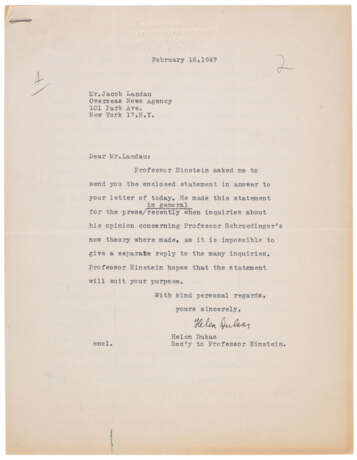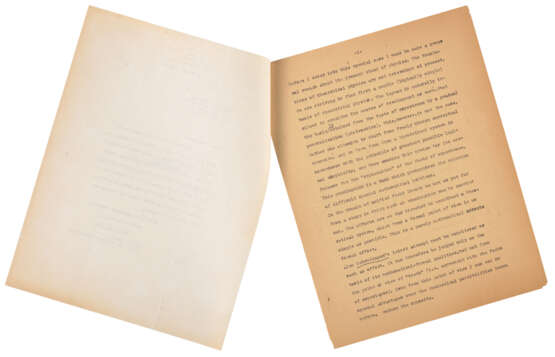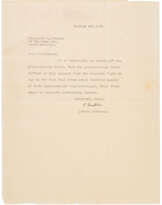ID 470230
Lot 61 | Albert Einstein (1879-1955)
Valeur estimée
£ 3 000 – 5 000
Statement on Schroedinger's unified field theory. 1947
EINSTEIN, Albert (1879-1955). Typed statement on Erwin Schroedinger’s proposed solution for the Unified Field Theory, n.p. [Princeton], n.d. [January/February 1947].
In English. 1 ½ pages, 279 x 216mm (acidified, tears to lower margin). Stapled to a typed letter signed by Einstein’s secretary, Helen Dukas, to Jacob Landau of the Overseas News Agency, 112 Mercer Street, Princeton, 18 February 1947 ('Professor Einstein asked me to send you the enclosed statement in answer to your letter of today. He made this statement for the press generally when inquiries about his opinion concerning Professor Schroedinger's new theory where [sic] made').
'Like the coup d’états in some of the smaller unstable republics': Einstein's scathing criticism of Schroedinger's proposed solution to the unified field theory, marking the end of their friendship and collaboration. Einstein prepares the ground for his critique of Schroedinger with a general statement on the current position of theoretical physics, noting that its foundations are as yet undetermined: 'We are striving to find first a usable (logically simple) basis', and this effort does not proceed, as the layman might expect, on the basis of generalisation from experimental facts but rather 'one attempts to start from freely chosen conceptual elements, and to form from them a theoretical system in accordance with the principle of greatest possible logical simplicity', which one can then examine for its usefulness. The search for a unified field theory is still very much at the theoretical stage, and 'far from a stage in which such an examination can be carried out ... This is a purely mathematical formal effort'. He then turns to Schroedinger's new theory which he underlines must be considered as one of these mathematical 'efforts': 'It can therefore be judged only on the basis of its mathematical-formal qualities, but not from the point of view of "truth"'. Einstein goes on to make a notably sarcastic criticism of Schroedinger's presentation of his new theory: 'It seems undesirable to me to present such preliminary attempts to the public in any form. It is even worse when the impression is created that one is dealing with definite discoveries concerning physical reality. Such communiqués given in sensational terms give the lay public misleading ideas about the character of research. The reader gets the impression that every five minutes there is a revolution in science, somewhat like the coup d’états in some of the smaller unstable republics', whereas in reality theoretical science is a gradual process over generations.
Schroedinger had announced his solution to the unified field theory problem at a lecture on 27 January 1947 with considerable fanfare, including a press conference at which he declared 'The nearer one approaches truth, the simpler things become. I have the honour of laying before you today the keystone of the Affine Field Theory and thereby the solution of a 30 year problem: the competent generalization of Einstein's great theory of 1915'. In fact, Schroedinger's theory was the result of several years of close collaboration and discussion with Einstein on the subject, and Einstein was deeply offended by his colleague's unexpected and, as it proved, ill-founded declaration of victory, criticising it publicly in the present statement with the damning phrase 'preliminary attempt' and in private breaking off their correspondence.
Einstein's statement is apparently formally unpublished: not in Boni, Russ, Laurence, A Bibliographical Checklist and Index to the Published Writings of Albert Einstein (1960). Extremely rare: no other copy recorded at auction.
| Artiste: | Albert Einstein (1879 - 1955) |
|---|---|
| Lieu d'origine: | Suisse |
| Artiste: | Albert Einstein (1879 - 1955) |
|---|---|
| Lieu d'origine: | Suisse |
| Adresse de l'enchère |
CHRISTIE'S 8 King Street, St. James's SW1Y 6QT London Royaume-Uni | |
|---|---|---|
| Aperçu |
| |
| Téléphone | +44 (0)20 7839 9060 | |
| Commission | see on Website | |
| Conditions d'utilisation | Conditions d'utilisation |









